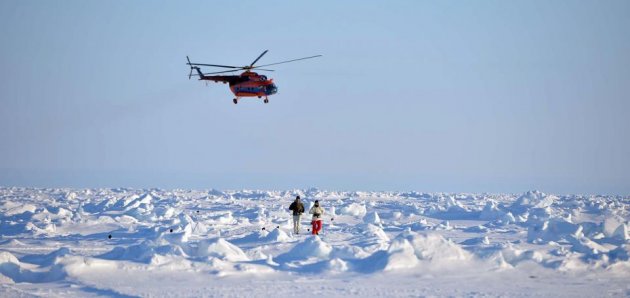TALK TO ANYONE who has run a marathon and they will explain that mental strength is just as important as being physically prepared.
That takes on a whole new meaning, however, when the race in question is being held in temperatures as low as -30 degrees celsius.
Gary Thornton, a primary school teacher from Galway City, embarked on an adventure of a lifetime with his wife Elaine last week and returned home having been crowned 2013 winner of the North Pole Marathon.
The 33-year-old, who is an experienced runner with Galway City Harriers, agreed to do his third ever marathon (Amsterdam and Rotterdam were the other two) after being invited to compete by the man who founded the event – fellow Galwegian and current race director Richard Donovan – last February.
“This opportunity came up and it was something different to what I had done so it just suited me,” Thornton told TheScore.ie. “The race is only a small part of what you’re up to up there. It’s a lifetime experience really and it’s somewhere you might never go again. It’s 90 degrees north you’re literally on top of the world.”
With a personal best of 2 hours 17 minutes, Thornton decided to set out on his usual pre-marathon training schedule and it wasn’t until they arrived in the town of Longyearbyen on the Norwegian island of Spitsbergen that he truly realised the scale of the challenge.
Along with the 45 other competitors, he attempted to acclimatise with some training before departing for the North Pole and also took the chance to test out what special clothing to wear, which as he explains, is a crucial part of a competition like this.
“I was wearing a base layer on my legs and my body,” he says. “Then I had a middle layer and outer shell jacket on the top half and the base layer and outer shell pants.
“Funnily enough, after about three laps of the race I actually started to overheat a bit. There are zips on the side of the jacket which you can open and it allows air to circulate and regulates your body temperature.
A few did drop out with hypothermia and that. Gear choices in this race is a huge factor. When you’r doing a city marathon all you’re looking at is your runners, shorts, singlet and your watch.
“The gear worked perfectly as the mid layer had ice on it but the base layer was dry. So it worked out well.”
Although there was a medical tent which you could call in to stock up on gear, gel or liquids on your way around the nine 4.7k laps, Thornton’s pre-race strategy involved running continuously in order to lower the risk of hypothermia.
“I was very conscious of not stopping. There was a guy there from New Zealand who had to stop and he got hypothermia within a few minutes. You’ve got to be careful of that.
“That was the mindset in my head. I didn’t want to leave stuff in the tent as I just wanted to keep going so I got my wife to carry my gels so I could keep going.”
 Credit: Facebook/North Pole Marathon
Credit: Facebook/North Pole Marathon
As the gruelling test of endurance and mental strength progressed, there was a slight drop in the temperature, which resulted in the course becoming considerably harder to run in.
"It did start to disintegrate after three laps. It just got deeper and deeper. It started off about -30 but got up to about -25. If it had remained cold the snow would solidify but it began to get much deeper and got tougher as the race went on.
You couldn't fight the course. During the first three laps I was fine, from three to six you started to feel it more and in the final three it was a real mental battle."
Like many athletics who push themselves to the limit in extreme conditions, Thornton has trained his mind to shut out everything around him and focus on one small thing to get him to the finish line.
"In a race like this you're going to be tiring and, for me, it's just about having that one focus. I was concentrating on the French guy who was behind me in second. In places like this anything can happen - you might have to stop and go into the tent and you lose ten minutes. I was determined to keep moving.
"With two laps left, I took a gel and was told my the time keeper that I was 20 minutes ahead of second. I knew I wasn't finished by any stretch so I just focused on his name."
Thankfully, he lapped his nearest rival with one to go and powered through the ribbon in a time of 3:49:29.
It's about managing the course as much as you can. A lot of people go out too hard. When you do that in them conditions it's a brutal experience. I felt relieved. It as much tougher than I thought it would be."
Upon his return to Ireland, staff and pupils at the school he teaches in, Claddagh National School, Galway City, marked his achievement with a party.
"There was a bit of a celebration in the school on Monday which totally caught me off. The reaction overall has been great. I didn't expect anything like this."
Asked finally, asked if he would be keen to do something similar again, he answers that while he is open to the idea, the immediate plan is to get back to the track and attempt to improve his times in at 5k, 10k and in the marathon... on solid concrete, that is.
Don't expect to hear about him signing up for the Antarctic Ice just yet then.

